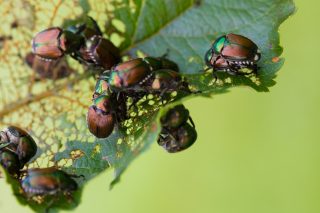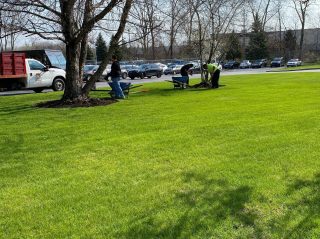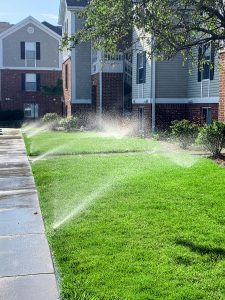Pests Are Invading: Stop The Infestation!
Lawn and landscape pests can wreak havoc on commercial properties, damaging landscaping, and causing unsightly and potentially hazardous conditions for occupants. As a commercial landscaping company, Priority Landscape understands the importance of preventing and treating pest infestations. In this blog post, we will discuss the most common lawn and plant pests that invade commercial properties in the northern United States, the risks they pose, and how to prevent and treat infestations.

Common Lawn and Plant Pests
Grubs, aphids, spider mites, and Japanese beetles are among the most common landscape pests that invade commercial properties in the northern United States.
Grubs are beetle larvae that feed on grass roots, causing brown patches on lawns. They are most active in late summer and early fall, and they can be identified by the C-shaped white larvae that live just below the soil surface. An infestation of grubs can weaken the turf and make it more susceptible to disease and other pests.
Aphids and spider mites are small insects that feed on the sap of plants, causing stunted growth and discoloration. Aphids are typically green, brown, or black and can be found on the undersides of leaves or in the curled-up new growth of plants. Spider mites are tiny and difficult to see without a magnifying glass, and they spin webs on the leaves of plants. Both pests reproduce quickly and can cause extensive damage if not treated promptly.
Japanese beetles are metallic green insects that feed on leaves, flowers, and fruits, causing extensive damage to landscaping. They are most active in midsummer and can be identified by their distinctive white tufts of hair along the sides of their abdomen.

The Risks of Pest Infestations
Pest infestations can have a significant impact on the health and aesthetics of commercial properties. Damaged landscaping can make a poor first impression on clients and customers, and hazardous conditions can put occupants at risk of injury. Additionally, untreated pest infestations can spread to neighboring properties and become more difficult and costly to treat.
Grubs, for example, can attract moles and other pests that tunnel through the lawn, causing additional damage. Aphids and spider mites can spread plant diseases, and Japanese beetles can attract predators such as birds and skunks, causing more damage to landscaping.
Preventing Lawn and Plant Pest Infestations
Preventing lawn and plant pest infestations in commercial properties involves several proactive measures. Regular lawn care and maintenance, such as proper watering and fertilization, can strengthen plants and make them less susceptible to infestations. Aeration and dethatching can also help prevent infestations by improving soil health and reducing thatch buildup, which can harbor pests.
Monitoring plants for signs of damage and early intervention with targeted treatments can also help prevent infestations. For example, beneficial insects, such as ladybugs and lacewings, can be introduced to the landscape to feed on aphids and other pests. Neem oil and insecticidal soaps are natural options for controlling pests, and systemic insecticides can be applied to plants to protect them from future infestations.

Treating Lawn and Plant Pest Infestations
If a lawn or plant pest infestation is already present, there are several treatment options available. Insecticides and fungicides can be applied to affected areas, and natural pest control methods, such as introducing beneficial insects, can also be effective. However, it’s essential to consult with a professional landscaping company to ensure that the correct treatment is selected and applied correctly.
Our work has always been a reflection of our clients, both commercial and industrial. Like you, we take pride in your property and our TOP PRIORITY is to provide the most reliable resources, knowledge, and service to achieve and retain a superior and sustainable landscape. Give us a call at (708) 946-6121 or email us at [email protected] today to enhance your commercial landscape appearance.



